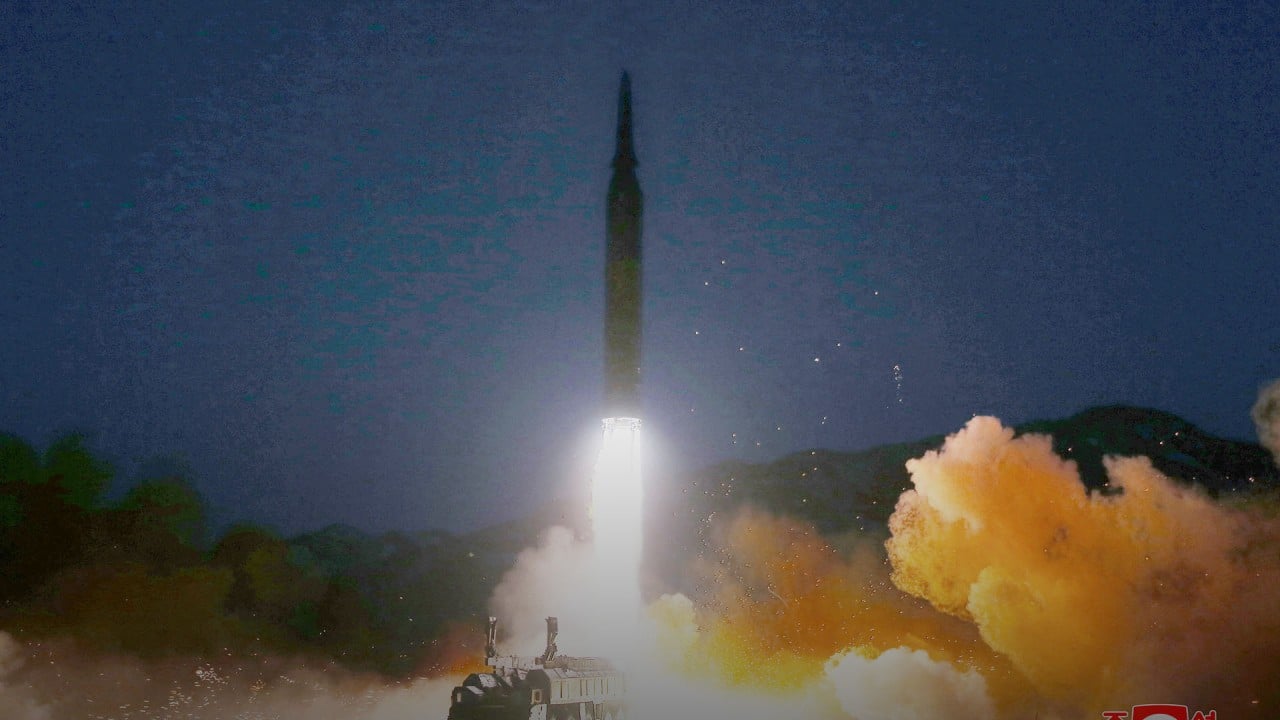
North Korea fires two ballistic missiles from Pyongyang airport in fourth test this month
- Seoul’s military said the test appeared to involved two short-range ballistic missiles fired east from Sunan Airfield
- The latest firings have drawn both condemnation and an appeal for dialogue from the US which has imposed fresh sanctions
Japan also reported the launch, with chief cabinet secretary Hirokazu Matsuno condemning them as a threat to the region’s peace and security.
In less than two weeks, nuclear-armed North Korea has conducted three other missile tests, an unusual frequency of launches. Two of those involved single “hypersonic missiles” capable of high speeds and manoeuvring after launch, while the last, on Friday, involved a pair of short-range ballistic missiles (SRBMs) fired from train cars.
Monday’s launch appeared to involved two SRBMs fired east from Sunan Airfield in Pyongyang, South Korea’s Joint Chiefs of Staff (JCS) said in a statement.
North Korea fires two missiles in response to US sanctions threat
The missiles fired on Monday travelled about 380km to a maximum altitude of 42km, the JCS said in a statement.
Japanese Defence Minister Nobuo Kishi said the missiles appeared to have landed in the ocean near North Korea’s east coast.
“It is self-evident that the aim of North Korea’s frequent missile launches is to improve their missile technology,” he told reporters.
“The repeated launching of North Korea’s ballistic missiles is a grave problem for the international community, including Japan,” Kishi added, noting that the launches were a violation of UN Security Council resolutions that ban Pyongyang from all ballistic missile development.
The US military’s Indo-Pacific Command said it assessed that the launch did not pose an immediate threat to the US or its allies, but “these missile launches highlight the destabilising impact of [North Korea’s] illicit weapons programme”.
The pace of testing and variety of launch sites suggests that North Korea has enough missiles to feel comfortable expending them on tests, training, and demonstrations, and helps reinforce its deterrent credibility by emphasising the volume of its missile force, said Mason Richey, a professor at Hankuk University of Foreign Studies in Seoul.
Pyongyang has not tested its longest-range intercontinental ballistic missiles (ICBMs) or nuclear weapons since 2017, but after denuclearisation talks stalled in 2019, began unveiling and testing a flurry of new SRBM designs.
Many of the latest SRBMs, including the hypersonic missiles, appear designed to evade missile defences. North Korea has also vowed to pursue tactical nuclear weapons, which could allow it to deploy nuclear warheads on such SRBMs.
“Every tactical missile launch flaunts how little sanctions have constrained the Kim regime, and how the US has failed to make North Korea pay a sufficient cost for short-range missile programme development,” Richey said.
The latest launches have drawn both condemnation and an appeal for dialogue from a US administration that has imposed new sanctions and is pushing for more.
North Korea’s missiles have a message for Biden: they can hit US back
China’s foreign ministry spokesman Zhao Lijian on Monday said Beijing hopes that relevant parties jointly promote the political resolution of Korean peninsula issues.
North Korea has defended the missile tests as its sovereign right to self-defence and accused the US of intentionally escalating the situation with new sanctions.
In a statement ahead of Friday’s missile tests, the North Korean foreign ministry said that although Washington might talk of diplomacy and dialogue, its actions showed it was still engrossed in its policy of “isolating and stifling” North Korea.

The launches came as North Korea, more isolated than ever under self-imposed border closings aimed at preventing a Covid-19 pandemic, appeared to be preparing to open at least some trade across its land border with China.
Chinese brokers said they expect the resumption of regular trade with Pyongyang as soon as Monday, after a North Korean train pulled into a Chinese border town on Sunday in the first such crossing since anti-coronavirus border lockdowns began in 2020.
“This timing suggests Beijing is more than complicit with Pyongyang’s provocations; China is supporting North Korea economically and coordinating with it militarily,” said Leif-Eric Easley, a professor of international studies at Ewha University in Seoul.
Last week China criticised the new US sanctions, but also called on all sides to act prudently and engage in dialogue to reduce tensions.
Beijing says it enforces existing international sanctions, but has joined with Russia to urge the United Nations Security Council to ease punitive measures on North Korea.


